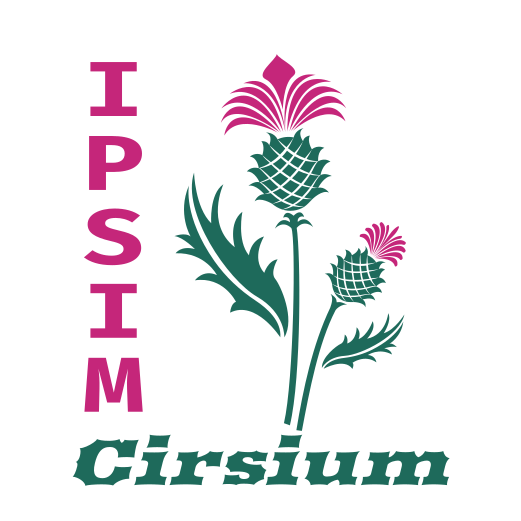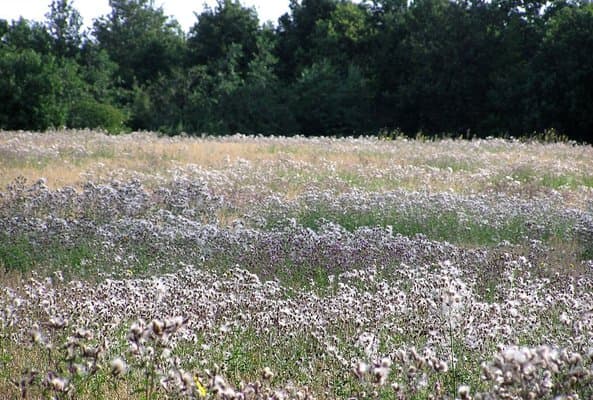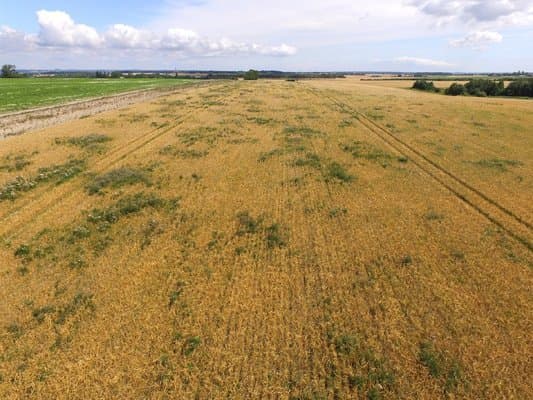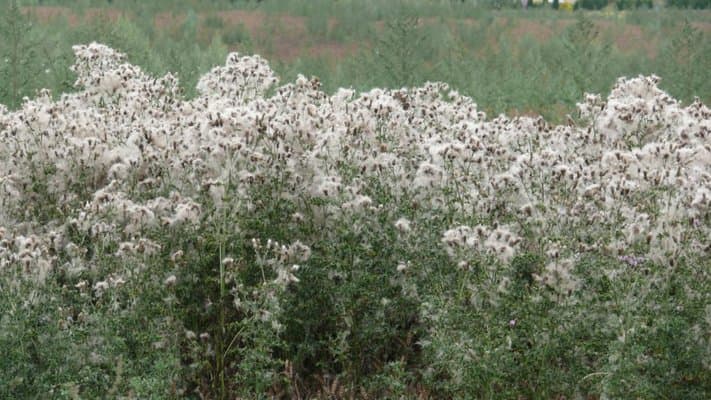
IPSIM-Cirsium is a model that tests the effectiveness of different technical options for managing infestations of the Common thistle.
This model can be used for a wide range of soil-climate conditions and cropping systems. Nevertheless, its predictive quality has only been evaluated on a French dataset (Lacroix et al, 2021).
The information entered to produce your result is not retained.


Last update : 2021-12-22
Logo ©DoAna
Photos © Jesper Rasmussen unless otherwise stated
The written content of this application is available under the CC-BY-SA 4.0 license and its code under the MIT license (© DoAna 2021). Source code : https://gitlab.com/doana-r/ipsimcirsium
This site is built with R and Shiny.
Site statistics (in accordance with the GDPR) by : Plausible analytics
I/ Initial infestation
Initial infestation
II/ Spring environment
Temperature
Rainfall
Soil compaction
III/ Cropping practices
Practices influencing competition
Herbicides
Mechanical work
Timeline
Evolution of the level of thistle infestation
Factors influencing infestation
Click on the bold circles for details on each influencing factor.
Relative impact on the presence of thistle at N+1
Ressources to go further
Popularisation
A video from Arvalis (in French) : Comment lutter contre le chardon des champs dans les céréales ?
A weed risk evaluation tool : Odera
Another application of the IPSIM model for fruit fly management in Réunion island : IPSIM-chayote
Institutional websites
Thistle and perennial weeds
Rasmussen, J., Azim, S., & Nielsen, J. (2021). Pre-harvest weed mapping of Cirsium arvense L. based on free satellite imagery–The importance of weed aggregation and image resolution. European Journal of Agronomy, 130, 126373.
Rasmussen, J., Nielsen, J., Streibig, J. C., Jensen, J. E., Pedersen, K. S., & Olsen, S. I. (2019). Pre-harvest weed mapping of Cirsium arvense in wheat and barley with off-the-shelf UAVs. Precision Agriculture, 20(5), 983-999.
AGROTRANSFERT, 2016. Fiche chardon. In : [en ligne]. Disponible à l’adresse : http://www.agro-transfert-rt.org/wp-content/uploads/2016/11/Fiche-chardon.pdf.
BAKKER, D., 1960. A comparative life-history study of Cirsium arvense (L.) Scop. and Tussilago farfara L., the most troublesome weeds in the newly reclaimed polders of the former Zuiderzee. In : Biology of Weeds, Symp. Brit. ecol. Soc. p. 205‑22.
BOCHENEK, GOLASZEWSKI et GORECKI, 2009. The effects of temperature on the dormancy and germination of Cirsium arvense [L.] Scop. seeds. In : Acta Societatis Botanicorum Poloniae. Vol. 78, n° 2, p. 105‑114
BONIN L et BIBARD V, 2009. Trois vivaces dans la ligne de mire. In : Perspectives Agricoles. n° 356, p. 73‑75.
DA, A., 2012: Cirsium arvense (L.) Scop in arable farming: Vegetative and generative reproduction as influenced by agronomic measures. PhD-thesis, University of Rostock.
DONALD W. W., 1990. Management and control of Canada thistle (Cirsium arvense). In : Reviews of Weed Science. Vol. 5, p. 193‑249.
FAVRELIÈRE E., 2019. Gestion des adventices vivaces en Agriculture Biologique. In : Agro Transfert [en ligne]. Disponible à l’adresse : http://www.agro-transfert-rt.org/wp-content/uploads/2019/10/Gestion-des-adventices-vivaces-en-AB-oct-19.pdf.
FAVRELIÈRE E., RONCEUX A., PERNEL J. et RODRIGUEZ A., 2016. Développement d’un outil d’aide à la décision pour la gestion du chardon des champs (Cirsium arvense) en systèmes de culture biologiques. In : Columa [en ligne]. Disponible à l’adresse : http://www.agro-transfert-rt.org/wp-content/uploads/2017/01/COLUMA-2016-outil-chardon_VF_FAVRELIERE_web.pdf
HETTWER U., FAN Z., DAU A. et GEROWITT B., 2002. Cirsium arvense (L.) Scop. in arable farming: establishment of plants and genetic diversity. In : 12th European Weed Research Society Symposium. p. 268‑269. Scopus
HODGSON, Jesse M., 1968. The nature, ecology, and control of Canada thistle. In : [en ligne]. Disponible à l’adresse : https://core.ac.uk/display/66219670.
Lacroix O, Aubertot J-N, Bohanec M, Cordeau S, Corrales DC and Robin M-H, 2021. IPSIM-Cirsium, a Qualitative Expert-Based Model to Predict Infestations of Cirsium arvense. Front. Agron. 3:655383.
Lacroix O., 2020. Qualitative modelling of the management of perennials weeds Elymus repens, Cirsium arvense and Sonchus arvensis, Agrocampus Ouest, Institut supérieur des sciences agronomiques, agroalimentaires, horticoles et du paysage, France.
MOORE R. J., 1975. The Biology of Canadian weeds : 13. Cirsium arvense (L.) Scop. In : Canadian Journal of Plant Science. Vol. 55, n° 4, p. 1033‑1048. DOI 10.4141/cjps75-163.
MOULIN Vincent, 2011. Maîtriser le chardon des champs (Cirsium arvense) en agriculture biologique. In : Demain la bio. Centre et Ile-de-France : s.n.
NADEAU L.B. and VANDEN BORN, W.H., 1989. The root system of Canada thistle. Canadian Journal of Plant Science, 69: 1169-1206.
RASMUSSEN J. et NIELSEN J., 2020. A novel approach to estimating the competitive ability of Cirsium arvense in cereals using unmanned aerial vehicle imagery. In : Weed Research. Vol. 60, n° 2, p. 150‑160. DOI 10.1111/wre.12402.
RODRIGUEZ Alain, 2007. Mises en réserve du chardon & conséquences pratiques. In : Alter Agri. 2007. n° 83.
Salonen J., et al., 2020. Agro-ecological management of creeping perennial weeds (AC/DC-weeds). Suomen Maataloustieteellisen Seuran Tiedote. 37: p. 313., http://www.smts.fi/sites/smts.fi/files/MTP2020%20Abstraktikirja.pdf
TRICHARD Aude, ALIGNIER Audrey, CHAUVEL Bruno et PETIT Sandrine, 2013. First results of weed evolution in no tillage systems in winter wheat in France. In : European Weed Research Society Symposium. Vol. 16, p. 1 p.
Agroecological crop protection
Deguine J. P., Gloanec C., Laurent P., Ratnadass A., & Aubertot J. N., 2016. Protection agroécologique des cultures. Éditions Quae. 287 p.
Deguine J. P., Gloanec C., Laurent P., Ratnadass A., & Aubertot J. N. (eds), 2017. Agroecological Crop Protection. Springer Science+Business Media B.V., Dordrecht, 280 p.
Hill SB, McRae RJ, 1995. Conceptual framework for the transition from conventional to sustainable agriculture. J Sustain Agric 7:81-87.
Hubert H, Couvet D, 2021. La transition agroécologique. Quelles perspectives en France et ailleurs dans le monde ? Tome 1 et 2. Presses des Mines, Académie d’agriculture de France, Paris
IPSIM model
Aubertot J. N. & Robin M. H., 2013. Injury Profile SIMulator, a qualitative aggregative modelling framework to predict crop injury profile as a function of cropping practices, and the abiotic and biotic environment. I. Conceptual bases. PLoS one , 8(9), e73202.
DEGUINE Jean-Philippe, ROBIN Marie-Hélène, CORALES David Camilo, VEDY-ZECCHINI Marie-Anne, DOIZY Anna, CHIROLEU Frédéric, QUESNEL Gauthier, PAÏTARD Isaure, BOHANEC Marko et AUBERTOT Jean-Noël, 2021. Qualitative modeling of fruit fly injuries on chayote in Réunion: development and transfer to users. Crop Prot 139:105367
Robin M. H., Colbach N., Lucas P., Montfort F., Cholez C., Debaeke P., & Aubertot J. N., 2013. Injury profile SIMulator, a Qualitative aggregative modelling framework to predict injury profile as a function of cropping practices, and abiotic and biotic environment. II. Proof of concept: design of IPSIM-wheat-eyespot. PLoS one , 8(10), e75829.
Robin M. H., Bancal M. O., Cellier V., Délos M., Felix I., Launay M., Sache I., 2018. IPSIM-Web, An Online Resource for Promoting Qualitative Aggregative Hierarchical Network Models to Predict Plant Disease Risk: Application to Brown Rust on Wheat. Plant disease , 102(3), 488-499.
Vedy-Zecchini M-A. 2020. Analyse et modélisation des effets du système de culture et de la situation de production sur les principaux bioagresseurs du tournesol. PhD, Agrosystèmes, Écosystèmes et Environnement, Institut National Polytechnique de Toulouse.
Acknowledgements
The construction of the IPSIM-Cirsium model was carried out by Octave Lacroix (INRAE, France) and Marie-Hélène Robin (EI Purpan, INRAE UMR AGIR). They used the software DEXi, developed by Marko Bohanec (Jožef Stefan Institute, Slovenia). Other contributors were: Jean-Noël Aubertot (INRAE, UMR AGIR), David Camilo Corrales (INRAE, UMR AGIR).
Many experts were mobilised for the construction and validation of the model: Alain Rodriguez (ACTA, France), Claire Cros (Agrotransfert, France), Bruno Chauvel, Muriel Valantin-Morison (INRAE, France), Catherine Vacher, Jean-Luc Verdier, Ludovic Bonin (Arvalis, France), Fanny Vuillemin (Terres Inovia, France), Enguerrand Burel (CREAB, France), Jean Arino (Agriculture Chamber of Gers, France), Bärbel Gerowitt, Marian Malte Weigel Sabine Andert, Han Zhang (Universität Rostock, Germany), Lars Olav Brandsæter (Norwegian University of Life Sciences, Norway), Kirsten Tørresen, Björn Ringselle (Norwegian Institute of Bioeconomy Research, Norway), Jukka Salonen, Timo Lötjönen (Natural Resource Institute Finland, Finland) and Jesper Rasmussen (University of Copenhagen, Denmark)
The observations on thistles used to evaluate the model were carried out by : Guillaume Adeux, Nicolas Munier-Jolain, Dominique Meunier (INRAE UMR Agroécologie ), Margaux Thirard (Chambre d'agriculture de l'Eure-et-Loire, France) and Régis Hélias (Arvalis, Institut du Végétal France).
The design, creation and implementation of the web interface were coordinated by Anna Doizy (DoAna - Statistiques Réunion). Other contributors were: Jean-Noël Aubertot (INRAe, UMR AGIR), Marie-Hélène Robin (EI Purpan, UMR AGIR) and Octave Lacroix (INRAE, France).
The hosting and maintenance of the application are provided by Jean-François Rey (INRAE, UMR BIOSP), Wilfried Heintz (INRAE, UMR Dynafor) and Anna Doizy. Thanks to Marie-Helene Moirez-Charron (INRAE, France) for the contacts.
The English translation was done by Anna Doizy.
Thanks to the beta-testers of the application: Robin Beghin (EI Purpan), Jean-Philippe Deguine (CIRAD, France), Violaine Deytieux (INRAE, France), Tom Doizy, Simon Giuliano (EI Purpan), Jean-Noël Rouchon, Fanny Vuillemin (Terres Inovia, France).
Thank you to all contributors!

Photo © Sabine Andert




